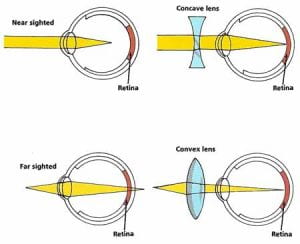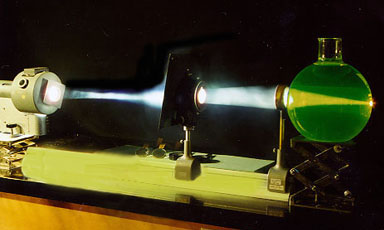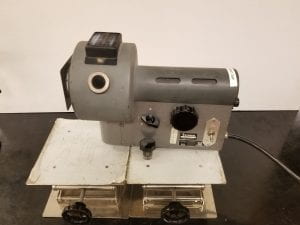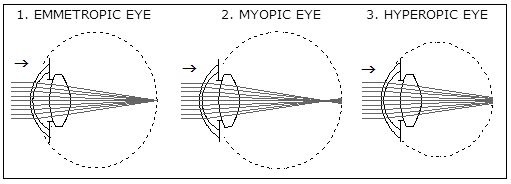A large glass flask filled with water and a bit of fluorescein is used to model the human eye. Interchangeable lenses are included to demonstrate normal, short-sight, and far-sight vision as well as corrective lenses (glasses).
Materials:
- 6L glass flask (with an “iris” represented by blue felt)
- Carbon arc lamp
- 2 jack stands
- Optical bench with lens holders
- Diaphragm
- Three “pupil” lenses
- Two corrective lenses
Setup/Demo:
Place the carbon arch lamp and 6L glass flask on jack stands with the optical bench holding the diaphragm between them (Figure 1). Then align the aperture of the arch lamp with that of the diaphragm and the blue felt iris of the human eye. Turn on the arch lamp and place any of the labeled pupil lenses after the diaphragm to show nearsighted, farsighted, and normal eye optics. To demonstrate the effect of corrective lenses, use the lens in the bronze holder for nearsightedness, and the lens in the black holder for farsightedness by placing one of them between the diaphragm and a pupil lens.
Explanation:
The human eye is a remarkably complex organ that can focus and detect light with electrical signals and optical sensors working in a near flawless system. However, it is not uncommon for this system to go awry when light is incorrectly focused within the eye. In general, these problems are a result of lenses in the eye over or under focusing the light, unideal eye shape, or a combination of the two (Figure 4).
These imperfections can be corrected with the help of lenses like those in glasses or contacts. If an eye over focuses light, glasses with concave lenses are used to correct this, while glasses with convex lenses are used if the light is under focused (Figure 5).

Figure 5: How corrective lenses aid faulty eyes in focusing light from Vainer Optical.
Written by Aleksander Beck



